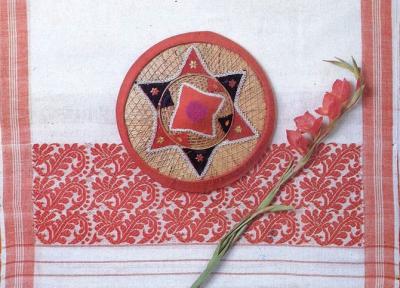|
Gamocha is a unique identity of Assamese Society. This small piece of cloth has high esteem and wide usage in Assamese culture. Gamocha is one unique cloth article in it's usage and looks, nowhere in the rest of India something like 'Gamocha' is found. Gamocha is also known as 'Bihuwaan', as it is an essential part of Bihu festival of Assam.
Origin:
The origin of Gamosa is still vague to the historians. It's not known whether it was originated
in Assam or came from far east like Thailand, where small clothes like Gamosa are in use. It's for
sure that Gamosa didn't come from other parts of India as there is no such article used
anywhere else in India. So, it can be assumed that Gamosa is a great innovation of Assamese
weaver.
Assamese Bohag Bihu is knocking at the door. It is being observe from the Domahi i.e., Sankranti falling on 14th April, the Assamese month of Bohag. Although its use is not rest for farmer as a waistcloth (tongali) or a loincloth (suriya); but at Bohag Bihu male dancers wraps it around the head with a fluffy knot. Guest of honour who ever comes to a family, normally for the first time he is welcomed with offering Gamocha. Significantly, the Gamocha is used equally by all the Assamese people; irrespective of religious and ethnic background. It is true that the materialistic civilization of today has shaken the age- old traditional way of life and values of the Assamese people. However, in spite of the numerous social, economic, cultural problems, the Assamese people welcome the Bihu in a genuine spirit of warmth and vitality year after year.
Design:
Gamosa is of rectangular shape, around 2 feet in width and 4 feet in height, closer to the shape of a towel. It's white in colour with red borders. One or two borders on the width, are woven with very artistic embroidery. The raw materialused for weaving Gamosa is cotton. But some gamosa used in special occassions are made of Silk too. Though it's pretty simple, weavers show their artistic talents in the motifs of a gamosa.
Historian Dr. Leela Gogoi mentioned the usage of Gamosa during Ahom days. There is also a reference of Gamosa from the days of Srimanta Sankardeva. "Sankardeva's disciple Srimanta Madhavdeva got the news of sad demise of Sankardeva when his son Ramananda Thankur came running wearing a Gamosa in his head." Edward Gaite's 'A History Assam' also mentions about Gamosa. According to this book in 1739 a Gamosa cost 6 paise. |








